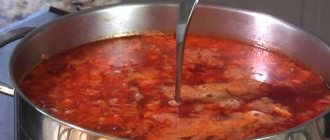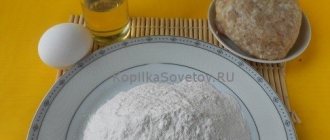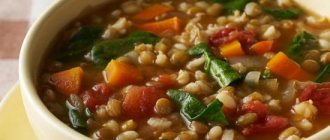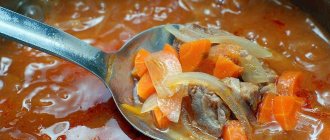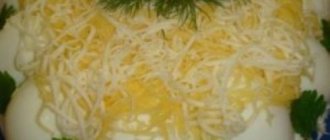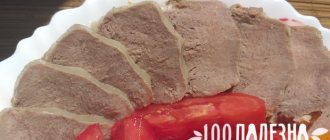In ancient times, the Slavs had a large number of delicious, vitamin-rich, healthy and at the same time very cheap dishes. One of them is considered to be botvinya, the classic recipe of which belongs to ancient Russian cuisine. As the name suggests, it was prepared from tops - sorrel leaves, beets with the addition of spinach, nettle, dill, quinoa, parsley. In general, all the greens that grew in the garden were used. Botvinya was poured with sour kvass. Later they began to add finely chopped radishes, fresh cucumbers, and beets to it.
On this topic:
Tasty and healthy - preparing viburnum jam for the winter
Aug 23, 2020
How to make apple cider at home -...
Aug 19, 2020
We reveal the secrets of how to properly ferment cabbage for the winter
Aug 19, 2020
A piece of sunshine in a jar - pumpkin juice, recipe in...
Aug 6, 2020
BACK FORWARD 1 of 129
Such a cold, common soup quickly gained popularity not only among the poor, but also took its place of honor at the festive and everyday meals of princes and kings. Only for noble people, botvinya was flavored with grated horseradish, and later lemon juice was added. It was served with boiled or salted fish, various seafood, and crayfish. A device with crushed ice was placed separately on the table for additional cooling of the dish. If previously separate cutlery was served for fish, ice and the botvinya itself, and they were laid out on different plates, now most often the botvinya is served immediately with ice and fish (seafood) in one container.
Incomplete Lenten botvinya, classic recipe
In ancient times, if tops were prepared from beet tops and other greens, it was called incomplete. A dish that was supplemented with fish or crayfish was called complete. The liquid component of the dish was also different. Botvinya was simply filled with kvass, and it was considered simple. If, in addition to kvass, the dressing included sourdough made from kvass grounds and flour, then botvinya was called steamed.
The easiest classic recipe is considered incomplete botvinya.
To prepare it you will need:
On this topic:
Winter preparation of beans in tomatoes - two in one: and...
Jul 25, 2020
For meat, fish, sauce and pizza - tomatoes in their own...
Jul 23, 2020
BACK FORWARD 1 of 254
- half a kilo of sorrel;
- 5-6 fresh cucumbers;
- 2 liters of kvass;
- a bunch of beet tops;
- green onions, parsley, dill - 50 g each;
- sugar, salt, horseradish, mustard - to taste;
- ice cubes.
Preparing cold soup is quite simple.
Cooking algorithm:
- The sorrel and beet tops are sorted out, washed, and placed in a saucepan. Pour in a small amount of water so that it just covers the greens. Boil in its own juice for 10 minutes, then grind through a sieve or grind with a mixer (blender).
- Green onions are washed, dried, chopped and mixed with horseradish or mustard, not forgetting to add salt.
- Peel the cucumbers and finely chop them.
- Transfer the sorrel-beet mixture into a dish, add onions with horseradish, and cucumber slices. Everything is filled with kvass. Decorate with chopped herbs and serve with a bowl of ice.
This is the simplest, most economical, dietary version of botvinya.
Recipe for Botvinya with chicken broth
Using broth will increase the nutritional value of the Botvigna and add flavor.
- Cooking time: 30 minutes.
- Number of servings: 2.
- Kitchen utensils: 2-liter saucepan, frying pan, grater, slicing board and knife.
Ingredients
| The product's name | Quantity |
| Chicken bouillon | 0.5-0.7 l |
| Young beets with tops | 2-4 root vegetables |
| Carrot | 1 PC. |
| Potato | 2 tubers |
| Young onion | 1-2 pcs. |
| Dill | 1/2-1 bunch. |
| Vegetable oil | 2 tbsp. l. |
| Tomato paste | 1 tbsp. l. |
| Egg | 2 pcs. |
| Garlic | 2-3 cloves |
| Salt pepper | taste |
Which products to choose
- beets, carrots, onions, and garlic young and, if possible, larger.
- potatoes , as young ones do not cook well.
- It is not necessary to use chicken broth. You can make beef soup by adding beet tops.
- Tomato paste can be replaced with your favorite tomato sauce if desired.
Cooking sequence
- Boil the broth.
- Cut the potatoes into cubes and place them in the broth. Let it cook until half cooked.
- Heat vegetable oil in a frying pan.
- Finely chop the onion and place in the pan.
- Grate the carrots on a coarse grater and add to the onions.
- Grate the beets, add them to the vegetables, and stir.
- Add tomato paste and pour in a few tablespoons of broth, simmer until tender and add to the broth.
- Coarsely chop the beet tops and add to the soup. Wait for it to boil, add salt and pepper.
- Chop the garlic, dill and green onions. Place them in the soup at the end of cooking. Remove from heat.
- Cut the boiled eggs into cubes and send them to Botvinya, or cut them into large pieces and decorate the soup, poured into plates.
Video recipe for hot botvinya
In the video, instead of vegetable oil, melted pieces of lard are used. Pay attention to when they are introduced into the recipe.
Cooking secrets
Since ancient times, the classic recipe for botvinya included only natural ingredients.
Using the following tips, you can prepare the right soup according to the ancient Slavic method:
- Kvass. Homemade kvass made from rye bread or beets is excellent for botvinya. The taste of botvinya largely depends on the choice of fizzy drink. It’s better to make kvass yourself than to buy something unknown in the store. There is nothing complicated in this process. Wort is made by steaming rye bread crusts with hot water. Leave them to ferment for a day in a warm place. Then add yeast with granulated sugar and leave to ferment for 6-8 hours. Strain and the kvass is ready! In the absence of a homemade drink, you can buy store-bought live fermented kvass.
- Beet. According to the classic recipe, beets for botvinya are chosen young, always with fresh, unwilted leaves. It contains the most useful substances, and the tops contain more of them than the root vegetables themselves.
- Additional components. Add wild garlic, spinach, quinoa, and nettle to the soup. Vegetables can be cut into small pieces, strips, cubes, halves of circles, or grated. This is a matter of aesthetic perception.
- Fish. If botvinya is prepared with fish, it is served separately or placed in the middle of a portioned dish. It is better to choose fillets or fish with minimal bone content for convenience.
- Innings. Botvinnik is decorated with chopped herbs and pieces of boiled egg.
Cold beetroot soup with kvass was so popular among connoisseurs of Slavic cuisine that culinary experts came up with a hot version. With a rich taste, aromatic, rich botvinya has already become a classic of gastronomy; it is prepared with meat, chicken, turkey, and even quail. But the main components still remain beet tops and sorrel. Instead of kvass, the recipe for classic hot botvinya uses rich meat broth.
Botvinya is one of the most popular dishes in Ancient Rus'. This cold soup is prepared simply, with minimal effort, and it contains a lot of vitamins, because the freshest ingredients are used and the dish is practically not subjected to heat treatment.
Classic botvinya is an excellent alternative to okroshka on hot summer days. It’s not for nothing that it was so popular even at princely and royal tables.
A simple recipe for Botvinya made from beet tops
Kitchen utensils: 2-liter saucepan, knife, cutting board.
Ingredients
| The product's name | Quantity |
| Young beets with tops | 4-6 root vegetables |
| Large beets | 1 root vegetable |
| Radish | 4-5 root vegetables |
| Dill | 1 bundle |
| Green onions | 1 bundle |
| Lemon | 1/2 pcs. |
| Fresh cucumber | 1 PC. |
| Salt | taste |
| Sugar | 1 tsp. |
| Egg | 1-2 pcs. |
| Water | 1 l |
| Sour cream | 2 tbsp. l. |
How to choose beets
Buy root vegetables the day they are prepared. Choose fresh, elastic vegetables with a root (without it, the beets will wither and dry out faster). Young root vegetables contain more useful substances than ripe ones. By the way, the tops contain several times more vitamins than the root vegetables.
Beetroot with tops:
- normalizes metabolic processes in the body, fighting atherosclerosis and diabetes;
- improves intestinal motility, eliminating constipation;
- activates hematopoiesis, making it recommended for anemia;
- contains iodine, useful for thyroid diseases;
- removes saturated fatty acids, promoting weight loss;
- improves memory and concentration.
Cooking sequence
- Boil large beets until tender and cover with ice water. This way it will cool faster and clean better.
- Boil and peel the eggs.
- Separate the young beets from the tops and cut into cubes.
- Wash the tops, separate the stems from the leaves and cut crosswise into 1.5 cm long sticks.
- Pour water over cubes of young beets and stems and cook for 10 minutes from boiling.
- Coarsely chop the leaves of the tops and add to the soup. Cook over low heat for another 2-3 minutes.
- Strain the broth through cheesecloth and set aside to cool.
- Peel and grate the boiled large beets and radishes.
- Cut the cucumbers the way you like. The main thing is that the slices are not very thin, otherwise the cucumbers will release juice and be tasteless.
- Chop the dill and finely chop the green onions.
- Mix all the vegetables and herbs with strained tops, add salt, and pour in the juice of half a lemon. If desired, sweeten, add mustard and/or grated horseradish.
- Place the prepared vegetables in portioned plates and pour the broth on top. Garnish with boiled egg halves and sour cream.
Video recipe for homemade botvinya
Pay attention to the thickness of the soup. If you like thinner soups, just add beetroot broth.
You can cook simple Botvinya using onion soup. In spring, sorrel soup will come in very handy. It is no less useful and accessible.
What is botvinya
This is the first dish that can be served either cold or hot. The dish belongs to Russian cuisine and can contain not only beet tops, but also other greens: spinach, sorrel, and nettle.
I have known this dish since childhood. In the summer, when young beets already look like a ball, we certainly use them together with juicy and at the same time tender tops. However, I do not use any other greens except parsley or dill. For lovers of borscht with nettles, you can check out this recipe.
Sometimes people figure out how to cook “botvinya borscht”, and sometimes “botvinya soup”. I would classify it as a dietary dish. The dish tastes like soup and looks like borscht. Delicate, not cloying, and at the same time interesting, original taste will delight any gourmet.
If you are a resident of a metropolis, then it is most likely difficult to get beets with tops. However, at the market, sellers sometimes offer bunches of beets with shoots. So they are suitable for botvinya.
Video recipes for beetroot botvina
Botvinya is served in bowls and bowls as a first course. It is also customary to eat it after the first hot dish as a liquid snack, before starting the roast. It is served with fish and crushed ice on a separate plate, as well as 2 spoons. The first to sip the soup, the second to put ice on the plate. Fish is eaten with a fork, which should also be on the table. The bread is only rye.
0
- 0
Rate the recipe:
If you liked the recipe, then share it with your friends via social networks and leave your comment. By spending just 10 seconds of your time on two clicks on the social network button, you will help our project. Thank you!
How to cook botvinya at home: recipe with step-by-step photos
- Our young beets with tops have just begun to grow in the garden; after all, the cold St. Petersburg summer is taking its toll. The tops have grown well, but the root crop itself is still small.
Therefore, for the botvinya, I took and boiled large beets from the old harvest.
To use beet broth for soup later, I washed it well in water and peeled it. I cooked the beets until tender for an hour.
You can not boil the beets for the botvinya, but bake them in foil, whichever you prefer.
If you have young beets with tops in your garden that have already grown well and have larger tubers - the size of radishes or eggs, then you can use only young roots and do not boil large beets additionally.
- Let's boil two hard-boiled eggs separately.
- While the beets and eggs are cooking, let's start chopping the vegetables. Separate the young tubers from the tops and cut them into small cubes.
- The washed tops must be cut - separate the thick stems from the leaves, since they will take longer to cook. Cut the stems into pieces of approximately 1 cm.
- The beets are almost cooked; at the very end, add salt to the broth and add a teaspoon of granulated sugar.
If you think sugar is unnecessary, you don’t have to add it, but I always put a little sugar in kholodnik, borscht or botvinya.
Squeeze half the lemon juice - the broth will immediately acquire a beautiful ruby hue.
By the way, if you still have apple cider vinegar in stock, you can add it to the soup instead of lemon juice.
If the beets are already cooked, take them out and let them cool. We cook cubes of young beets together with chopped stems into the beet broth, which will give it an even brighter, richer color. Cover the pan with a lid and let the soup simmer for 5-10 minutes.
- We cut the tops larger than the stems themselves, approximately 2 cm thick.
You can also cut the leaves of nettle, young sorrel, spinach into botvinya - the soup will only benefit from this.
At the very end, add the chopped tops to the pan and cook them for no more than 3 minutes (practically blanch them).
This is done so that the leaves of the tops do not lose their taste, color and beneficial vitamins.
- Strain the beet broth and leave it to cool.
Look how beautiful, rich, bright it is.
Then, when it cools down completely, it will become darker.
- And into the boiled tops we grate the beets on a coarse grater, then the radishes, having first cut off their tail and base.
Radishes will give our botvinya, just like lemon juice, a pleasant sourness.
- I cut the cucumber into strips, you can cut it into cubes, it doesn’t matter.
The main thing is that you need to cut it at the very end, the last of all the vegetables, so that it does not lose its juice.
- But what you shouldn’t skimp on in Botvinya is greens. The abundance of greens will make this soup even tastier, so chop the green onions and dill.
I took more onions and less dill, and you cook according to your preferences.
- Mix all ingredients well and add salt. Those who like it spicier can add pepper to taste, add a little grated horseradish or mustard.
- We generously put the prepared vegetables on the bottom of the plate and pour all this splendor with chilled beetroot broth.
I squeezed the juice from the second half of a lemon into the cold beet broth.
By the way, instead of beet broth, you can use bread kvass or take them in equal quantities.
Botvinya is especially tasty when cooked on your own.
- In the finished soup we put half a boiled egg, whiten it with a spoonful of sour cream and eat the vitamin-packed, summery, light soup with great pleasure.
My family didn’t wait for the beet broth to cool completely and began to eat the botvina warm - it was impossible to tear it off by the ears.
This is how delicious young beet soup turns out!
Bon appetit!
If you have men in your family who cannot do without meat even in the heat, then you can put a piece of any boiled meat, poultry or a piece of red fish in the botvinya for greater satiety.
And use meat broth along with beet broth as a base.
In general, you can experiment to your taste and discretion.
And lastly, if you have nowhere to get beets with tops, don’t be upset, nothing is stopping you from making summer beet soup, and instead of tops take spinach, sorrel or nettle leaves.
It’s just that you won’t get botvinya, but beetroot soup, but that’s another story.
Friends, did you like the recipe? Tell us about it in the comments and share your culinary experience. It is very important for me to know your opinion, this will make the site more interesting and useful. I will be glad to see your ratings and reposts of this article on social networks. This is how you say thank you to the blog. Don't miss new recipes - join the group
Botvinya
- one of the oldest dishes of Russian cuisine. For many centuries it has been a delight for gourmets, earning the title of the queen of Russian cold soups. Unfortunately, now botvinya has faded into the background due to the length of cooking and the non-standard set of products, giving way to a democratic and uncomplicated okroshka. Many references to botvinya have been preserved in the literature.
In the “Culinary Dictionary”
V.V. Pokhlebkin gives the following description of botvinya:
“A cold soup dish made with kvass from boiled beet tops, nettles and quinoa, green onions, cucumbers and lightly boiled red fish, both fresh and salted-smoked. In addition, borage and dill were added to the botvinya.”
Please note that classic botvinya does not include beets among the ingredients. They began to add it much later, blurring the line between botvinya and beetroot. By the way, according to nutritionists, beet tops contain much more vitamins and nutrients than the root vegetable itself.
The basis of botvinya is kvass. It appeared back in the 9th century and for centuries was not just an everyday drink, but also the basic basis for many dishes - cold stews, appetizers, sweet and flour dishes. Vegetables and meat were stewed together with kvass, and for the common people kvass with black bread and green onions was the main food in the summer heat. They even steamed and doused themselves with kvass for health. The mix of vegetables and kvass gives the botvinya its characteristic color. In I.A. Goncharov’s “Frigate “Pallada””
you can find the following comparison - the sea is “brown-greenish, like botvinya”.
. Mentions of it can be found in the works of S.T.
Aksakova, I.A. Goncharova, A.F. Pisemsky, D.N. Mamin-Sibiryak, Gilyarovsky , but probably the most “delicious” description belongs to
I.S.
To Shmelev : Old Gorka, come eat some botvina with us! Well, well, you didn’t have much lunch, and botvinya with whitefish is not every day... don’t stand on ceremony! And the table is cheerful. My father always makes the botvinya himself. Around a white earthenware bowl with blue rims there are plates, and on them everything is cheerful: a green mound of finely chopped onions, a dark green mound of fragrant dill, a golden mound of crushed orange zest, a white mound of shaved horseradish, a brown-green mound with toppings, a stack of thin circles, with grains - fresh cucumbers, a bowl of crystal ice, a block of beluga, in grains, sticking out like a hump in stains, flaps of tender whitefish, juicy and pinkish-pale, a film of golden balychka with a reddish edge. All this smells in its own way, viscous, fresh and pungent, fills the whole room and merges into that wonderful thing called botvinya. The father, having rolled up his strong cuffs in large gold cufflinks, cheerfully stirs everything in a bowl, drinks kvass from a decanter, and foam hisses with bubbles. It's hot: botvinya is just right now. Everyone eats cheerfully, crunching cucumbers, cartilage - hrukhru.” I. Shmelev, “Politics”
Emperor Alexander I held botvinya in special honor. At the Congress of Vienna in 1814, the tsar gave lunches and dinners for 350 or more people with “gastronomic rarities,” including botvinya. There is a historical anecdote associated with it, published in the magazine “Russian Archive”
:
Tsar Alexander Pavlovich was very disposed towards the English ambassador. Once, while talking to him about Russian cuisine, he asked if he had any idea about botvinya, which the Tsar himself loved very much. Having learned that the ambassador had never tried this dish, the Emperor promised to send it to him. The ambassador lived on Palace Embankment, not far from the palace. The Emperor, eating botvinya, remembered his promise, which he immediately fulfilled. The messenger mistook this dish for soup and ordered it to be heated. During the meeting, the Emperor did not forget to ask how he liked the botvinya. The diplomat hesitated a little and finally explained that, of course, the heated food can no longer be as good as the freshly prepared one.” (Russian Archive magazine) For foreigners, botvinya was something exotic and extreme, like a Russian bathhouse. The unusual taste combination in addition to the ice component perplexed them, and few dared to try it. At the Trinity tavern, the baron was placed by his friend in an almost life-threatening situation: first of all, he was asked for botvina with ice; the baron was terribly thirsty for this dish and was afraid; however, he began to eat it and felt bliss and fear with each bite; Then the prince wanted to serve him two-day-old cabbage soup, but the baron tried it and absolutely could not eat it.” A.F. Pisemsky, “In the Whirlpool” But among the foreigners who tried botvinya there were also connoisseurs. These include the French writer and gourmet Alexandre Dumas
. They say that it was the creator of “The Three Musketeers” and “The Great Culinary Dictionary” who named botvinya the queen of Russian cold soups.
On the Russian table, botvinya was an integral part of a gala dinner.
“Everything was prepared with such skill and with such deep knowledge of the human stomach that there was hardly anything left to be desired. The action opened with an unusually sophisticated botvinya.”
(Mamin-Sibiryak, Privalov’s Millions) Each housewife had her own recipe for this dish, and the secret ingredients of the festive botvinya were passed down from generation to generation. The ability to cook botvinya was an indicator of the culinary abilities of the housewife. It was considered a shame if the housewife cooked it poorly. There was even a saying: “Like Aksinya, so is Botvinya.” A complete botvinya consists of three parts and is served in three plates: the botvinya itself; boiled fish; crushed ice The fish part in botvinya ideally consists of different types of red fish (boiled and salted), supplemented with crayfish meat (crabs, shrimp). The best base for botvinya is regular drinking kvass mixed with white okroshka in a 1:1 ratio (the proportions can be changed to taste). You can make okroshechny kvass yourself. Its composition is very simple - rye bread, water, sugar and yeast. Okroshechny white kvass
Ingredients
: 500 grams of rye bread 3.5 liters of boiling water 0.5 cups of granulated sugar 15 grams of yeast (or 5 grams of dry)
First of all, prepare rye crackers - cut the bread into small pieces and dry in the oven. Place them in a three-liter jar, pour 2 liters of boiling water and leave for 2 hours under the lid in a warm place. Strain the resulting bread infusion and pour into a separate bowl, and pour the remaining bread mass again with 1.5 liters of boiling water and leave in a warm place for 2 hours. Strain the second infusion and mix with the first. Add sugar, the amount can be varied according to your own taste. Stir thoroughly until the sugar is completely dissolved and add the diluted yeast. Leave the infusion in a warm place to ferment for 12 hours. Strain the finished kvass and bottle it, you can add mint leaves, crushed cranberries, lemon zest, 2-3 raisins, seal tightly and put in the refrigerator for a day. Do not throw away the remaining grounds - they will serve as a starter for new portions of kvass. There is no need to add yeast, just water and sugar.
There are many recipes for botvinya. For example, this one from Elena Molokhovets
(with champagne)
Botvinya
.
Peel, wash, boil one and a half pounds of sorrel in its own juice, rub through a sieve; put 6 pcs., i.e. 1 pound of fresh cucumbers, peeled and cut into square pieces, a handful of finely chopped green onions, mashed with a full spoon of salt, a full spoon of sugar, ½ spoon of prepared mustard or a spoon of grated horseradish. Add dill; dilute all 2 bottles. Bavarian kvass, you can add an incomplete bottle. sour cabbage soup. Serve separately, in salted water with onions, a bunch of herbs, and laurel. leaf and pepper boiled salmon, salmon, white fish, whitefish or crayfish necks and separately finely chopped ice. You can add sherry or champagne." (Elena Molokhovets, “Gift for Young Housewives”)
Botvinya simple complete from V.V. Pokhlebkin
1 liter of bread kvass, 0.25 liters of white kvass, 1 glass of nettle, 1 glass of sorrel, 3 young beets with tops, 1 - 1.5 fresh cucumber, 1 - 2 tbsp. tablespoons grated horseradish, 0.5 lemon, 1 teaspoon mustard, 0.5 - 0.75 cups green onions, 1 teaspoon salt, 1 teaspoon sugar, 1.5 tbsp. spoons of dill, 0.4 kg of fish, 4 crayfish (or 1 jar of krill), 0.5 cups of beet broth.
Preparation of botanical mass
. Lightly simmer the tops of young beets and the roots separately until soft. In the same way, lightly boil (no more than 3 minutes) whole sorrel leaves. Rinse the nettles thoroughly in cold water, then scald with boiling water and drain in a colander. Chop all the greens finely with a sharp knife and measure according to the recipe. Do not rub or pass through a meat grinder under any circumstances, otherwise the botvinya will turn into a puree soup and its taste will change. Then add finely chopped beet roots to the green mass, as well as finely chopped green onions, grated with salt and dill.
Preparing the kvass base and combining it with the botanical mass.
Combine both types of kvass.
Cut the zest from the lemon, grind it with sugar in a cup, add lemon juice, mustard, horseradish, a little kvass, beet broth, mix and pour into the bulk of the kvass. Combine the kvass base with the botanical mass, add cucumber cut into small cubes and let stand in the cold for 15 - 20 minutes - the mixture should brew, and the sour base should be absorbed into the tops. Meanwhile, prepare the fish part of the botvinya. Preparing fish for botvinya.
Boil a set of pieces (50g each) of red fish of different types (sturgeon, stellate sturgeon, salmon) in a small amount of boiling salted water with onion, dill, black pepper and bay leaf: freshly salted and salted-smoked fish - for 2 - 3 minutes, raw - 10 min.
The use of uncooked salted, and even more so salted-smoked fish is excluded, since it does not combine with the sour base and spoils the taste of this expensive and difficult to prepare dish. Botvinya eating order
.
Pork is served either as a first course, or after a hot first course as a liquid appetizer before a roast. Two spoons and a fork are served with it: they take the fish with a fork, sip the botvina with the first spoon, and periodically put pieces of ice into the botvina from a cup with ice so that it remains cold all the time. Only fresh rye bread goes with botvinya. (V.V. Pokhlebkin, “National cuisines of our peoples”)
A fairly simple recipe for botvinya is given by P. Weil and A. Genis in the famous “Russian Cuisine in Exile”
:
Lightly simmer beet tops and sorrel until soft, chop finely along with cucumber, green onions and dill, pour in kvass and add horseradish, mustard and lemon juice. In a small amount of boiling water, boil pieces of salted and smoked fish - sturgeon, salmon, halibut - for 2-3 minutes. Combine with the base and let sit in the cold for at least an hour.
Botvinya restaurant
.
Shch and spinach are sorted out, washed, poached separately and rubbed or ground in a meat grinder. The resulting puree is diluted with kvass, chopped and scalded lemon zest is added. This liquid part of the botvinya is cooled and poured into plates or soup bowls. A side dish is served separately on a plate or dish: chopped green onions, fresh cucumbers cut into strips, chopped green salad, grated horseradish, slices of boiled and smoked fish. In the old days, botvinya was prepared with sturgeon fish.
For the liquid part: bread kvass 700, spinach, sorrel 100-120 each, lemon 1/10, sugar. For garnish: green onions 50, fresh cucumbers 200, salad 50, horseradish 50. For serving: boiled fish 100. N.I. Kovalev “Russian cuisine”
Botvinya is the “queen” of Russian cuisine from the category of cold soups. In modern cooking, this dish is less popular due to the complex and labor-intensive cooking process. But experienced housewives do not cross it out of their cookbook.
The editors will reveal all the secrets and subtleties of preparing botvinya and share with you recipes for this soup, modernized in a modern way.
